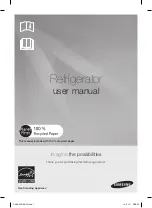
37
User instructions
6.4
Keeping deep-frozen foods
When buying deep-frozen foods, always make sure that the packaging is not damaged, the product has not
past its expiry date and the thermometer of the freezer in which the food is displayed for sale does not
indicate a temperature above –18°C. Also note the manufacturer's instructions regarding temperature,
period for which the food can be kept and consumption methods. You are also advised to protect the foods
you have bought with suitable insulated containers during transport to avoid defrosting. A temperature
increase may reduce the period for which the food can be kept and affect the quality of it.
Do not buy deep-frozen products covered in large amounts of frost: they may have already defrosted.
FOOD
STORAGE PERIOD (IN MONTHS)
1
2
3
4
5
6
7
8
9
10
11
12
Vegetables
+
+
+
Fruit
+
+
+
Bread and confectionery
+
Milk
+
Ready meals
+
Meat: beef
+
+
+
veal
+
+
+
pork
+
+
+
poultry
+
+
+
game
+
+
+
minced meat
+
Smoked sausage
+
Fish: oily
+
non-oily
+
Chitterlings
+
To avoid any alterations in the quality of frozen foods, do not exceed the permitted storage
period, which varies depending on the type of food.
6.5
Defrosting deep-frozen foods
You are advised to consume partially defrosted foods as soon as possible. Low temperatures preserve
the foods but do not destroy the microorganisms which become active after defrosting, potentially
leading to a deterioration in the products. If the smell and appearance of defrosted foods appears to be
unchanged, they can be cooked and potentially refrozen after they have cooled.
To defrost frozen foods correctly, depending on the type of food and the intended use, they can be
defrosted at room temperature, in the fridge, in an electric oven (static or fan-assisted oven function) or
in a microwave oven using the appropriate setting.








































